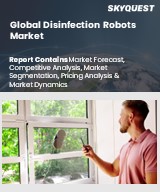
Report ID: SQMIG45M2013

Report ID:
SQMIG45M2013 |
Region:
Global |
Published Date: February, 2024
Pages:
157
|
Tables:
93 |
Figures:
76
Disinfection Robots Market Driver
Large Scale Disinfection required in Hospitals to Drive the Demand for Disinfection Robots
Disinfection Robots Market Restraint
Limitation in Performance and High Cost Associated with Maintenance to Hinder Market Growth
Our industry expert will work with you to provide you with customized data in a short amount of time.
REQUEST FREE CUSTOMIZATIONDisinfection Robots Market size was valued at USD 538.126 million in 2019 and is poised to grow from USD 714.78 million in 2023 to USD 7697.57 million by 2031, growing at a CAGR of 32.84% in the forecast period (2024-2031).
Want to customize this report? This report can be personalized according to your needs. Our analysts and industry experts will work directly with you to understand your requirements and provide you with customized data in a short amount of time. We offer $1000 worth of FREE customization at the time of purchase.

Report ID: SQMIG45M2013